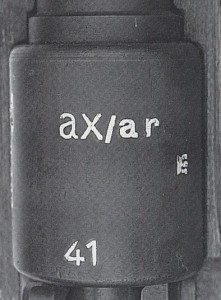Recently, a question was raised about Mauser-Berlin’s production of the so called “dual coded” rifles, that began in late 1941 and ended in 1943, – the same year Mauser-Berlin dropped carbine (Kar.98k) production to focus on MG42 production.
I thought this would be a good subject for discussion, so examination of known examples follow. It seems that Mauser-Berlin took delivery of leftover ERMA (ax code) receivers late in 1941, when they dropped rifle assembly to focus on MP40 production (They would continue making 98k receivers, though primarily as a sub-contractor for JP Sauer). The first rifles show up in the “L” block of 1941; however it is the “M” block when most show up, mostly late in the block and very near the end of 1941 production. They linger into the first block of 1942 production (no suffix).

Most ax-ar coded rifles were probably made at the very end of Mauser-Berlin’s 1941 production run; though it is likely many were not finished until early 1942. This is because of the characteristics found on the known rifles. First, Mauser-Berlin production serialed both the receiver and the barrel until very late in 1941, typically this changed in the last block of Mauser-Berlin production, the m-block. In that block you will start to see the rationalization changes, ordered by Hitler and imposed upon the German military, to simplify production. This process is best shown in rifle production with a reduction of markings and finish standards that you will see on late 1941 and throughout 1942 production, – it also accounts for the reason ERMA, and later Mauser-Berlin, would be redirected to other projects, and away from rifle production.
The actual changes that determine when a rifle was assembled, finished, is this serial number change, going from serialing both the receiver and the barrel, to only serialing the receiver. Also the acceptance pattern must be considered. Prior to the late “L” block, early “m” block, Mauser-Berlin applied three acceptance stamps to the right side of the receiver. This changes in the last two blocks of 1941 production. Progressively during these last two blocks serialing of the barrel will end and the right receiver acceptance will drop; later it will be replaced by a final acceptance on the top of the receiver, this occurs early in the 1942 “b” block. In the range between late 1941 and the b-block of 1942, most receivers will lack a top final and most acceptance on the receivers.
The above outline describes how you date these “dual code” rifles, which is more important when dealing with the Astrawerke (bcd marked) receivers that Mauser –Berlin used in large numbers throughout 1942 and 1943. You see, the date on the receiver is not necessarily when a rifle was made, especially with these “dual code” receivers. A 1941 dated bcd/ar serialed in the f-block (which exist), which lacks a serial on the barrel and has a top final was made in the f-block of 1942, – such situations are often encountered and one needs to examine the acceptance and serial pattern, along with the barrel coding to know when rifles were made.